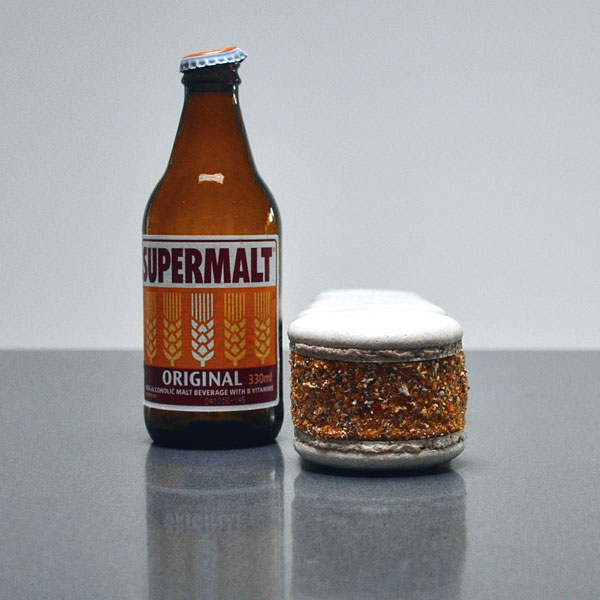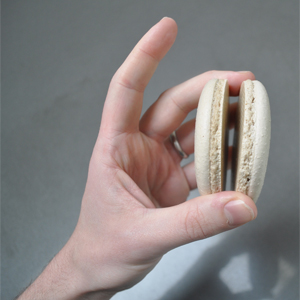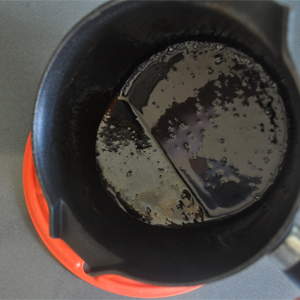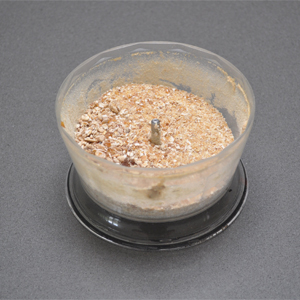Supermalt Ice Cream Macaron
Supermalt flavoured ice cream covered in malt & oat caramel

Supermalt always divides people. It's a non-alcoholic, naturally brewed malt drink; if you've ever had "Start" (a favourite cereal from my childhood) it's basically a liquid version of that.
I think the depth of malt flavour is really off-putting to some, but this recipe is the perfect carrier to get them to try it.
I've rolled the ice cream in a caramel made with more of the Supermalt & some toasted oats to give it a bit of texture. Try it - I guarantee you won't make this face.
Makes 8 macaron
Ingredients
For the ice cream
- 1 x 330ml bottle of Supermalt (you'll use 250g in this part of the recipe)
- 500ml double cream
- 150g caster sugar
- 5 large egg yolks
- A pinch of salt
For the macaron shells
- 150g Ground almonds
- 150g Icing sugar
- 110g Egg whites
- 150g Caster sugar
- 37ml Water
- 3g Brown powdered food colouring (Americolor)
For the caramel
- Remaining Supermalt
- 100g caster sugar
- 20g porridge oats
Equipment
- Stand mixer
- Ice cream maker
- Silicone mats
- 8cm circular cutter
Make the ice cream
Weigh 250g of Supermalt out into a large saucepan. Pour 500ml of double cream - straight from the fridge so it's cold - into a metal bowl. Place a fine sieve over that.
In another bowl (ideally one with a non-slip base, or put it on a kitchen towel) place the 5 yolks and 150g of sugar and a pinch of salt. Whisk these until the yolks become pale.
Heat the Supermalt until it nearly boils, then temper the yolks with a quick pour of the liquid. Keep whisking the yolks, then add a bit more Supermalt. Keep going until all the liquid is in the yolk mix, then pour the lot back into your saucepan and put over a low heat.
Keep stirring with a wooden spoon, and make sure it doesn't catch or scramble. When it's thick enough to coat the back of the spoon (just run your finger down the middle of it - if it leaves a trail, it's done). Immediately pour this through the sieve into the cream and stir with a clean spoon.
Leave this to cool, then put it in your freezer to chill for 15 minutes. Loads of people say "freeze overnight" - I find that a bit weird if you're using an ice cream machine. Instead, while the mix is cooling, I put my machine on freeze mode to get it cold. When 15 minutes are up, start the paddle and pour your mix in.
Once churned, you'll want to scoop out the ice cream into a container that is reasonably high-sided so that you can get a good tall circle out of it with the cutter. This mix makes about 1 litre of ice cream, and I normally use a 20cm cake tin with a removable bottom. Scoop it in, smoothen the top then put back in the freezer until you're ready to serve
Make the macaron shells

I use the Italian meringue technique by Pierre Hermé to make the shells - but everyone has their own tweaks to get consistent results at home.
Start by preparing everything - have your baking mats on some heavy trays, get out the piping bag and place the nozzle inside. Measure out the 150g of caster sugar and 37ml of water into a small pot and place on your stove top with a thermometer inside. Measure out 55g of your egg whites into the bowl of a stand mixer, and connect the whisk attachment
Now put the 150g of icing sugar in the bowl of a food processor, followed by the 150g of ground almonds (putting the sugar in first helps to stop it leaving the processor in a cloud of dust). Blend for a few minutes to make sure everything is as fine as possible. At this point, tip the mix into a new bowl (one big enough to fix this mix and the meringue later) and re-weigh to make sure you have exactly 300g of dry ingredients. Top up if necessary. Take the remaining 55g of egg white and place in a small bowl, then add the brown food colouring and mix. If you can't find the powder colour, paste is the next best thing. Avoid liquid food colouring if you can, as they tend to dilute the mix too much. Pour this mix on top of your dry ingredients and set aside.
Start to heat your sugar / water mix in the pot over a high heat. Keep going until you hit around 112 deg C. Turn on your stand mixer to a medium high speed to get the whites whipping - remember not to go too mad with the speed at this point; you don't want stiff peaks nor soft ... somewhere in between is perfect. As the temperature of the sugar / water mix hits 118 deg C exactly, quickly remove from the heat, push up the mixer to high and slowly trickle the hot syrup onto the whipping egg whites in one smooth motion. Now leave the whites whipping until much cooler. If you raise the whisk and the meringue drips off quickly, don't despair - you've probably not left it mixing long enough, so just keep going until it comes away on the whisk and pretty much stays there.
Take a spatula and transfer all of the Italian meringue you've just made into the bowl with the dry ingredients you prepared earlier. Fold with the spatula until you get the desired consistency - to me, this is the crucial point where things can go wrong, and it's really hard to actually explain or even take a photo of the correct consistency. All I can say is that if you drop the mix from a spatula, and it doesn't re-absorb into the mix without trace in about 15-20 seconds, it needs more mixing. If it's more liquid than that, and just flies off the spatula, it's game over for you. Pierre describes it as "slightly runny cake dough". Make sure you get right to the bottom of the bowl though, or you may leave unmixed colour or ground almond at the bottom.
When ready, hold the piping bag and fold the top of it over your hand. Use the spatula to transfer the mix inside, then twist the top (put a kitchen clip on it if you like - I've lost mix many times by wandering aimlessly around the kitchen, not realising batter is dripping out behind me) cut off the end and get ready to pipe. I always have a bit if kitchen roll ready to clean the nozzle if too much mix clogs around it. This helps you pipe more perfect circles.
On the baking mats (and I would advise the Silpat-style ones over silicone, and both of those over just using greaseproof/baking paper - much easier to get them off later) pipe larger than normal rounds to hold the ice cream - about the size of the cutter (8cm), keeping your nozzle as straight as possible. Keep about an inch between each round; you don't want to overcrowd the shells. Carry on until you've filled the mat, then rap the baking tray on your work surface with relative force a couple of times. This helps to settle the batter, and is important not to forget. The French pros always do a little "whip" at the end of each pipe to stop the nipple effect (when a bit of the batter sticks up in the air), but in general I find these subside when you rap the trays. If not, you can use a wet finger to gently smoothen out any stray batter.
Repeat with the other mat so you have two full sheets. Turn your oven on to 140 degrees C, set the sheets aside in the kitchen for 30 minutes to form a skin while you make the filling.
Make the caramel
 This is a two stage process, just to make sure we don't burn the malt flavour right out.
This is a two stage process, just to make sure we don't burn the malt flavour right out.

Now, take the other 50g and place it in another saucepan - preferably a silver / light colour one that you can watch sugar changing colour in. Heat the sugar, shaking occasionally. You want to bring it to an amber colour - normally that's right at the moment you start to see smoke coming from it. When you hit the point, remove from the heat and immediately pour over the top of the Supermalt syrup you've just made. Leave aside to harden.
Place a pan over a high heat, and add your porridge oats. Toast them until they're brown, then set aside.
When both the caramel has set and the oats have cooled, hit the caramel with the back of a knife to smash it (be careful, those shards can kill!) then place both the oats and caramel in a blender and whiz it to a slightly chunky powder.
When you're ready to assemble, pour the powder into a shallow bowl
Assembly
If you've used a cake tin with removable bottom, remove the ice cream completely from it. If you've just used a plastic box or similar, you might need to cut around the circles to release them.
Cut 8 circles from the ice cream, and set them aside on a tray.
At this point the ice cream will have slightly softened - if not, give the edges a quick blow-torch to melt them. Pick each one up by its flat top & bottom and roll it in the powdered caramel mix, then place back on the tray.
I'd not recommend putting them back in the freezer after rolling - the caramel will probably start to deteriorate
Place each cut ice cream on a macaron base, and match with the lid. Serve and enjoy!
comments powered by Disqus









